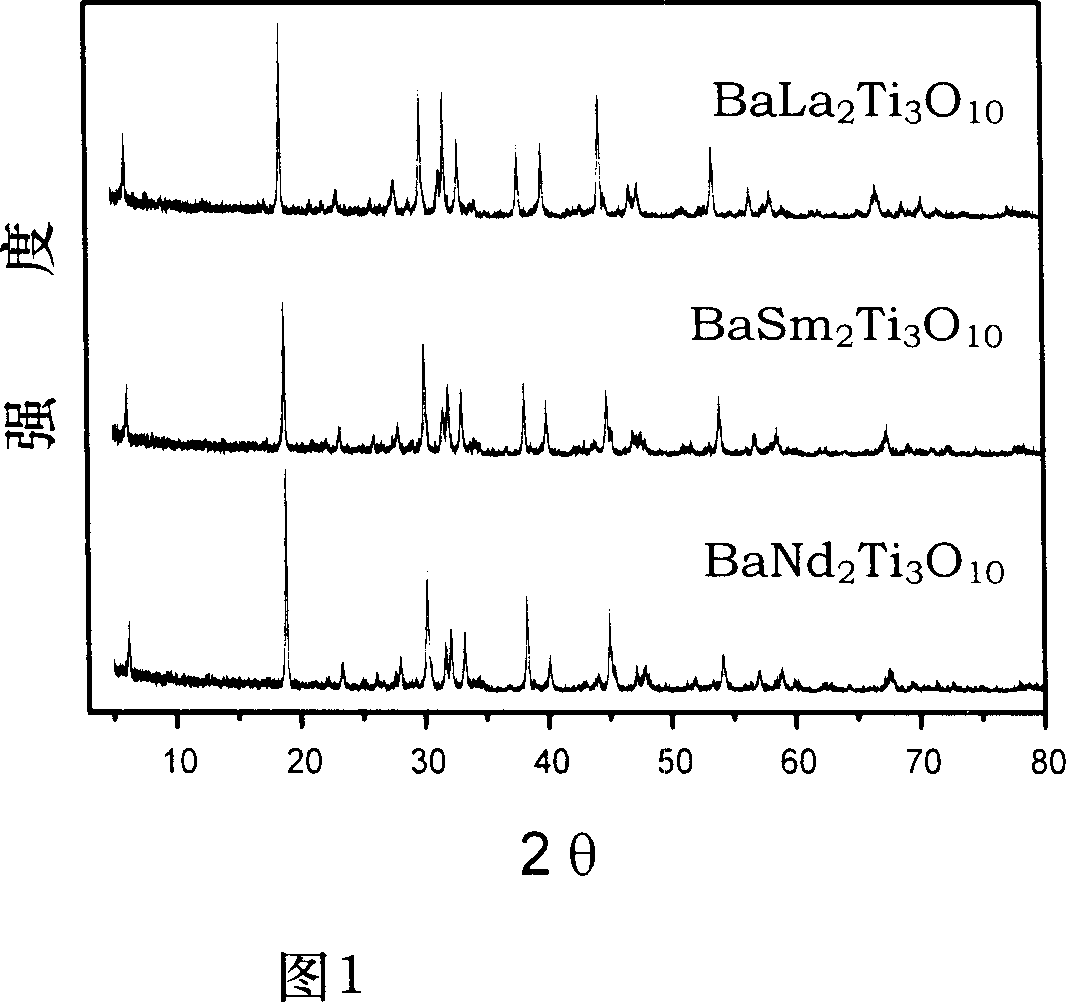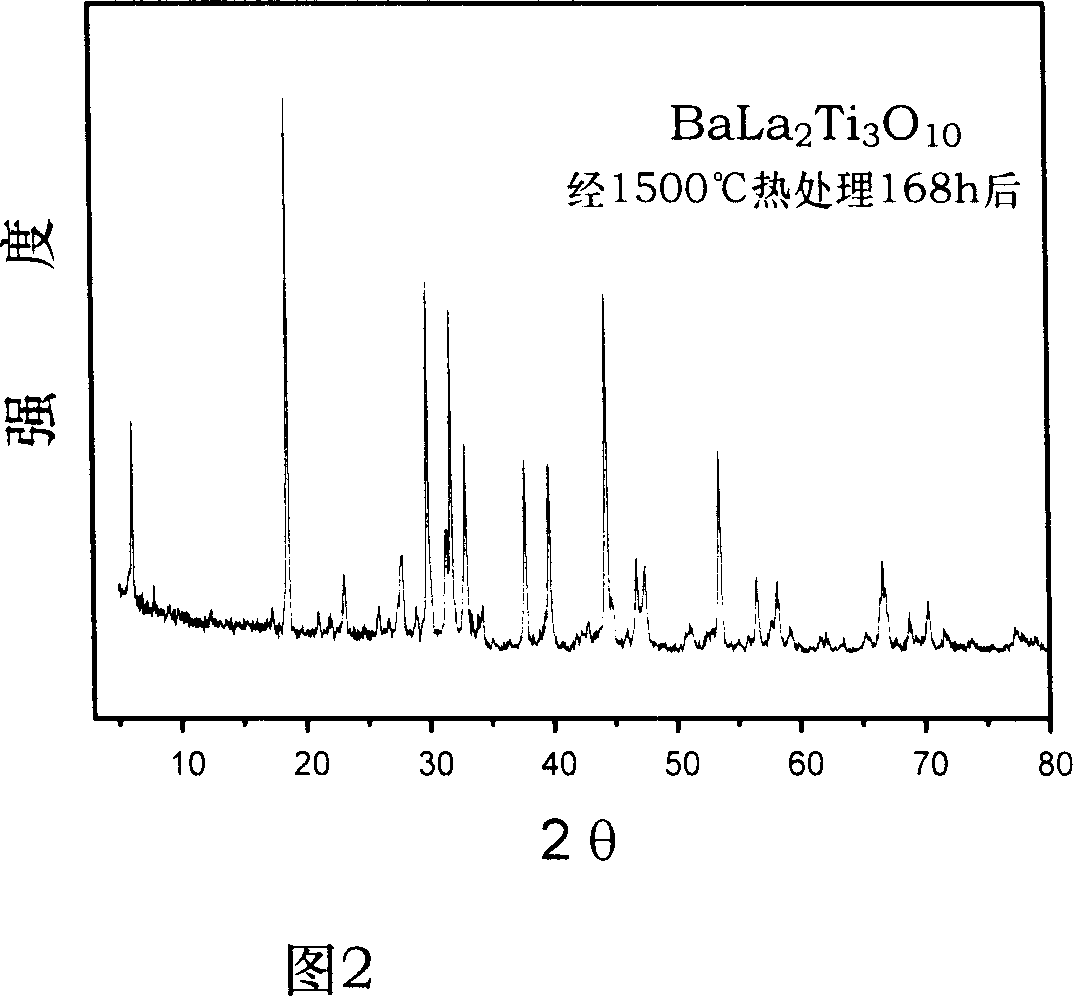Laminated perovskite structure heat-barrier coating ceramic layer material
A technology of perovskite structure and thermal barrier coating, applied in the field of ceramic layer materials, can solve the problems of volume change of the coating, easy to break, can not meet the design requirements of aero-engine, etc., achieve low thermal conductivity, prevent oxidation and other problems. Effect
- Summary
- Abstract
- Description
- Claims
- Application Information
AI Technical Summary
Problems solved by technology
Method used
Image
Examples
preparation example Construction
[0017] The method for preparing a thermal barrier coating ceramic layer material with a layered perovskite structure of the present invention has the following steps:
[0018] The first step: the powder BaCO 3 、TiO 2 , La 2 o 3 、Sm 2 o 3 , and Nd 2 o 3 After grinding for 40-80 minutes by wet ball milling method, a fine powder with a particle size of less than 1 micron is obtained; after drying in a drying oven at 70-300°C for 60-300 minutes, take it out to obtain a dry fine powder for use;
[0019] The second step: weigh the BaCO obtained in the first step 3 Dry fine powder 15~30wt%, TiO 2 dry fine powder 15-30wt% and the balance of dry fine powder rare earth oxide; the precursor is prepared by mixing uniformly;
[0020] The rare earth oxide is La 2 o 3 、Sm 2 o 3 , and Nd 2 o 3 One or a combination of two or three of them, wherein, when two rare earth oxides are selected, the metal ion number ratio is 0.1-1.9:1.9-0.1, and when three rare earth oxides are selecte...
Embodiment 1
[0025] Embodiment 1: make BaLa 0.8 SM 0.6 Nd 0.6 Ti 3 o 10 Ceramic material
[0026] The first step: commercially available barium carbonate BaCO 3 , titanium dioxide TiO 2 , Neodymium trioxide Nd 2 o 3 , Lanthanum trioxide La 2 o 3 and samarium trioxide Sm 2 o 3 After grinding for 40 minutes by wet ball milling, a fine powder with a particle size of less than 1 micron was obtained; after drying in a drying oven at 100°C for 200 minutes, a dry fine powder was obtained, which was taken out for use;
[0027] The second step: take the dry fine powder after the first step treatment, 197.34g of barium carbonate, 239.70g of titanium dioxide, 100.93g of neodymium trioxide, 130.32g of dilanthanum trioxide and 104.64g of samarium trioxide, and mix them uniformly to obtain Precursor;
[0028] The third step: put the precursor obtained in the second step into the SSX high-temperature furnace of Shanghai Experimental Electric Furnace Factory, adjust the temperature to 1500°C,...
Embodiment 2
[0032] Embodiment 2: make BaLa 1.2 SM 0.8 Ti 3 o 10 Ceramic material
[0033] The first step: commercially available barium carbonate BaCO 3 , Lanthanum trioxide La 2 o 3 , Samarium trioxide Sm 2 o 3 , titanium dioxide TiO 2 1. After grinding for 45 minutes by wet ball milling method, a fine powder with a particle size of less than 1 micron is obtained; after drying in a drying oven at 150° C. for 120 minutes, a dry fine powder is obtained for use;
[0034] The second step: take the dry fine powder after the first step treatment, 197.34g of barium carbonate, 195.48g of dilanthanum trioxide, 139.52g of samarium trioxide, and 239.70g of titanium dioxide, and mix them uniformly to obtain a precursor;
[0035] The third step: Put the precursor obtained in the second step into the SSX high-temperature furnace of Shanghai Experimental Electric Furnace Factory, adjust the temperature to 1650°C, keep it at 1650°C for 40 hours, and then cool to room temperature with the furnac...
PUM
| Property | Measurement | Unit |
|---|---|---|
| Thermal conductivity | aaaaa | aaaaa |
| Thermal expansion coefficient | aaaaa | aaaaa |
| Thermal conductivity | aaaaa | aaaaa |
Abstract
Description
Claims
Application Information
 Login to View More
Login to View More - R&D
- Intellectual Property
- Life Sciences
- Materials
- Tech Scout
- Unparalleled Data Quality
- Higher Quality Content
- 60% Fewer Hallucinations
Browse by: Latest US Patents, China's latest patents, Technical Efficacy Thesaurus, Application Domain, Technology Topic, Popular Technical Reports.
© 2025 PatSnap. All rights reserved.Legal|Privacy policy|Modern Slavery Act Transparency Statement|Sitemap|About US| Contact US: help@patsnap.com


